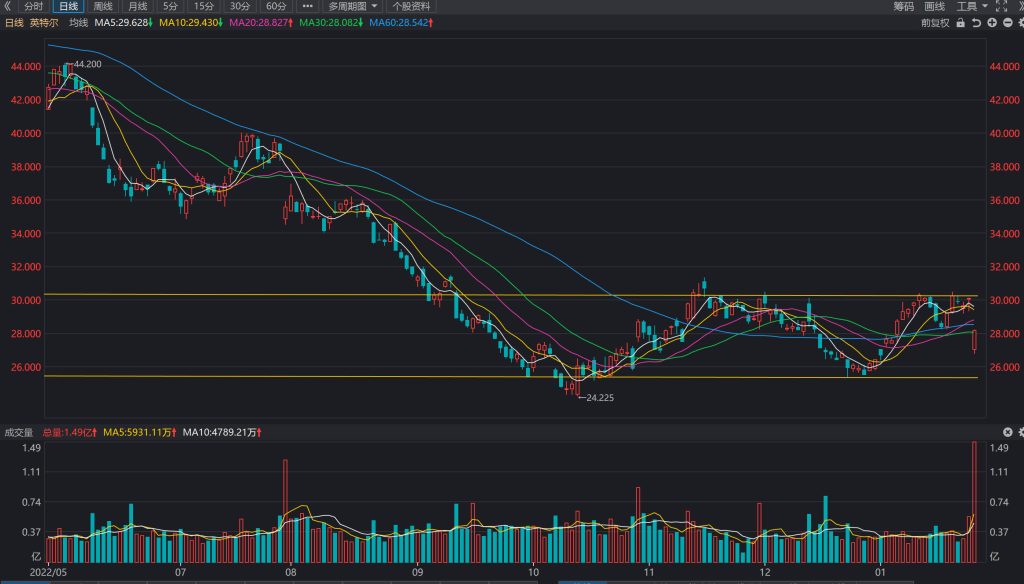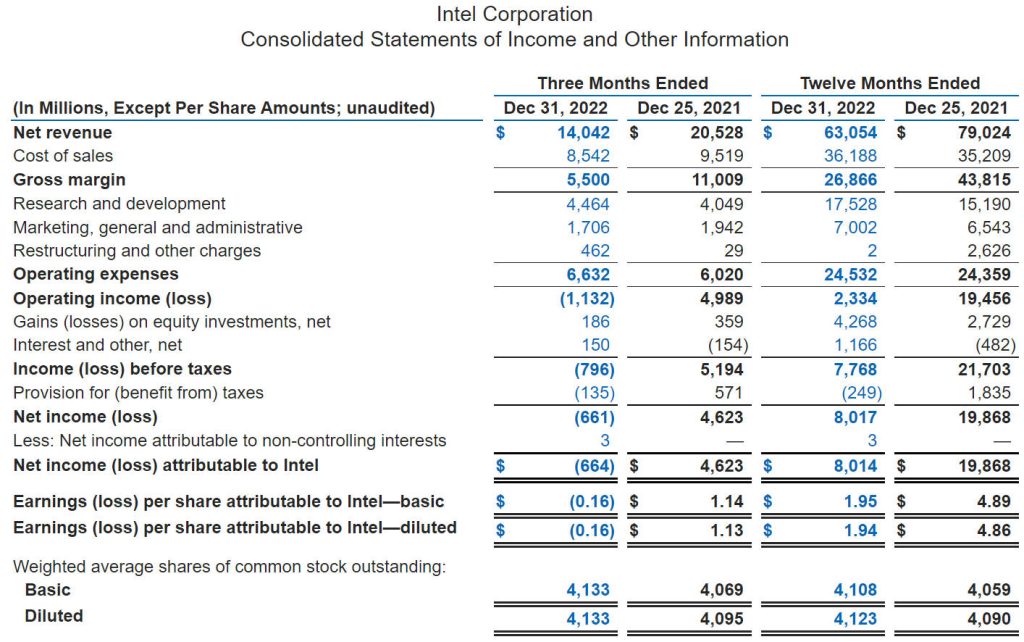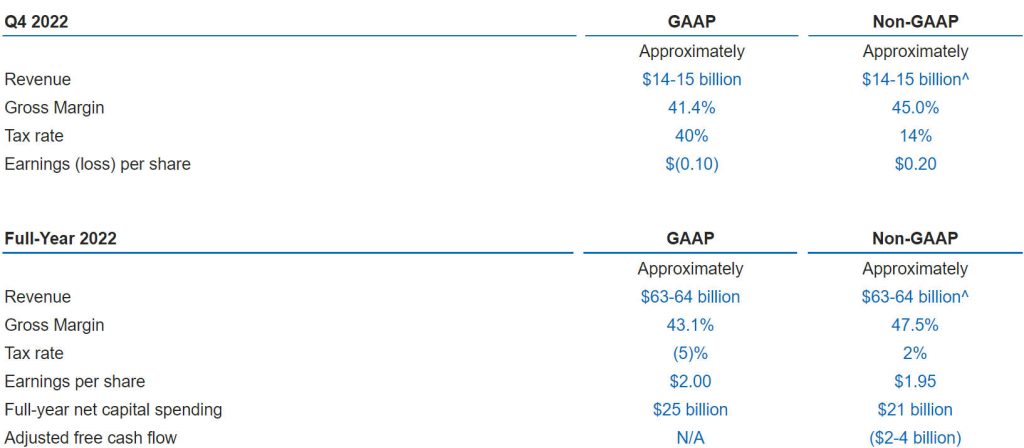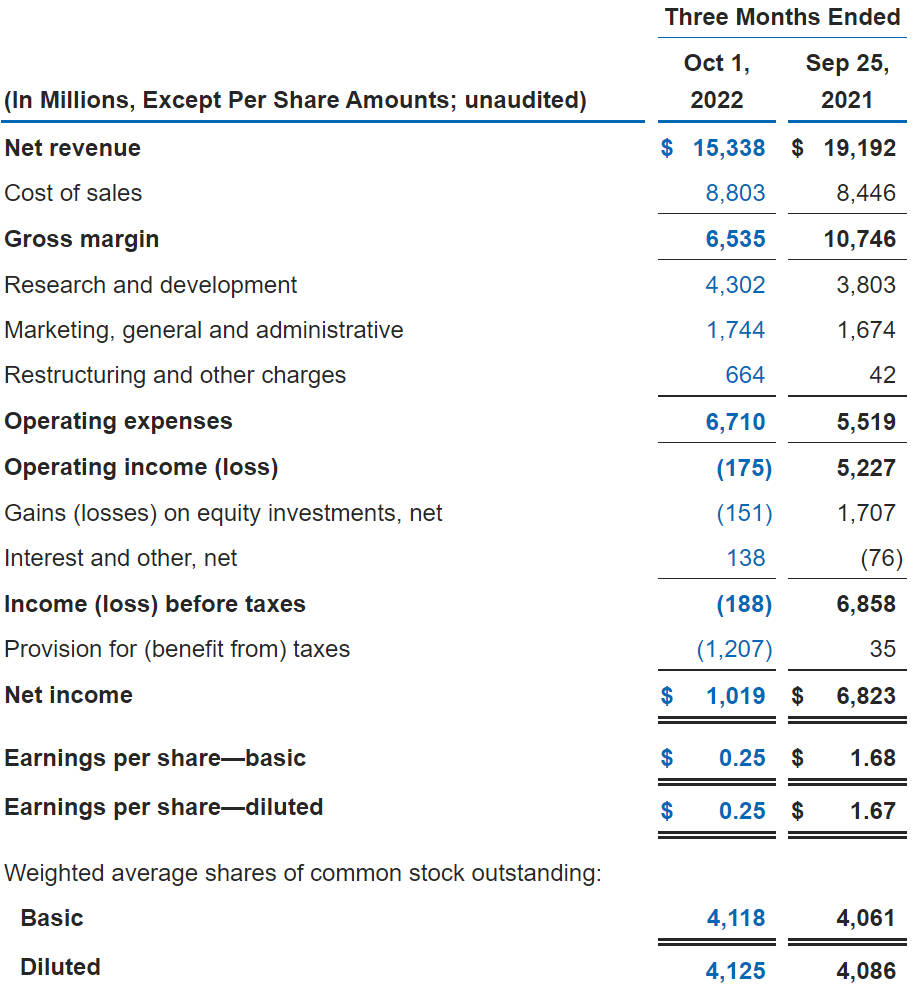Intel Corp. (NASDAQ:INTC) Stock price trend forecast and trading range:
Updated to: 2023.1.27
(Note: The upper red line in the picture is the resistance, and the lower red line is the support)
Analysis from stock chart
———————————————–
Short-term trend: bearish
Sell high and buy low of range : $26.5 – $30
Support: $26.5 resistance: $30 Stop Loss Price: $26.5 price target: $30 Buy the position again: stop fall and rise to $26.5
Medium-term trend: neutral
High sell low buy range: $26 – $31
Support: $26 resistance: $31 Stop Loss price: $26 price target: $31 Buy the position again: stop fall and rise to $26
Long-term trend: bearish
High sell low buy of range: $26 – $36
Support : $26 resistance: $36 Stop Loss price: $26 price target : $36 Buy the position again: stop fall and rise to $26
————————————————————————-
From Analysis from financial statements:
In Q4 2022 revenue of US$14.042 billion, market expectations of US$15.316 billion, YoY-32%。Forecasting first-quarter 2023 revenue of $10.5 billion to $11.5 billion; expecting first-quarter EPS of $(0.80) (non-GAAP EPS of $(0.15)). a Capital IQ consensus of $0.25 on revenue of $14.02 billion.Revenue continued to decline sharply more than expected, but there is no need to be overly pessimistic, and mid-term and long-term holding profitability is large.Wait patiently for the inflection point of performance.
Historical Forecast Record:
Updated to: 2023.1.6
Short-term trend: stop falling and rebound
Sell high and buy low of range : $27 – $30
Support: $25 resistance: $30 Stop Loss Price: $27.5 price target: $30 Buy the position again: stop fall and rise to $26
Medium-term trend: Short-term stop falling
High sell low buy range: $27 – $31
Support: $25 resistance: $31 Stop Loss price: $27 price target: $31 Buy the position again: stop fall and rise to $26
Long-term trend: Short-term stop falling
High sell low buy of range: $27 – $36
Support : $25 resistance: $36 Stop Loss price: $26 price target : $36 Buy the position again: stop fall and rise to $26
In fiscal 2022, Q3 achieved revenue of $15.338 billion, market expectations of $15.316 billion, YoY-20.08%, net profit of $1.019 billion, YoY-85.07%, EPS of $0.25, YoY-85.03%, market expectations of $1.75. R&D expenses were US$4.302 billion, YoY+13.12%. Quarterly dividend of $0.365 per share. Third-quarter adjusted earnings per share were $0.59, versus market estimates of $0.33. Adjusted revenue for the fourth quarter is expected to be $14-15 billion, analysts expect $16.29 billion, and the company is committed to achieving an annualized spending reduction target of $8-10 billion by 2025. The risk of further decline in sales revenue continues, with a focus on next quarterly earnings, and the company is currently in a major transition period, and the stock price can currently retain a small number of positions for long-term tracking. The short-term and medium-term trading strategies are dominated by technical indicators.
2022.12.23 From the stock chart analysis, the recent stock price fell again below the previous $28-$30 range, the stock price fell below $26 short-term, but the probability of another downward test is low, the probability of stock price fluctuations between $26-$30 has risen sharply, it is recommended to sell high or hold between $26-$30 in the short term, and $26 in the middle line is a better buying point. The target price is between $38 and $40. The worst for companies may be over. The long-term price target is between $45 and $50.
2022.11.17 From the technical chart, the previous low of $24.225 can basically be confirmed as the bottom range of the medium and long-term, and then falling below means that the company has a larger operating problem rather than a demand problem. From the K-line pattern, the short-term downside space has been temporarily sealed, the recent volatility range is expected to be between $26-$32, the upward pressure is obvious, after a short shock then choose the direction. Short-term trading is recommended to try to be near the lower band of the range of $26-28 first-line anti-weak or high sell low, the mid-line target can be seen around $36. There is no long-term holding space for the time being. From a fundamental point of view, Q3 of fiscal 2022 achieved operating income of $15.338 billion, market expectations of $15.316 billion, YoY-20.08%, net profit attributable to common shareholders of $1.019 billion, YoY-85.07%, EPS $0.25, YoY-85.03%, and market expectations of $1.75. R&D expenses were US$4.302 billion, YoY+13.12%. Quarterly dividend of $0.365 per share. Third-quarter adjusted earnings per share were $0.59, versus market estimates of $0.33. Adjusted revenue for the fourth quarter is expected to be $14-15 billion, analysts expect $16.29 billion, and the company is committed to achieving an annualized spending reduction target of $8-10 billion by 2025. The risk of further decline in sales revenue continues, with a focus on next quarterly earnings, and the company is currently in a major transition period, and the stock price can currently retain a small number of positions for long-term tracking. The short-term and medium-term trading strategies are dominated by technical indicators.
2021.10.24 From the technical chart, the financial stimulus volume fell to around $49.5, and the recent focus on the support of $48, from the technical chart, has broken the level, opening up downside, but from the historical trend, usually this is a stage bottom. The near-term volatility range is expected to remain between $48 and $52. Short money trading can be fast-forward and fast-out within the range. Move down below the range trading range, pay attention to the stop loss. From a fundamental point of view, operating income continues to grow, and medium and long-term long positions continue to be held.
2021.10.22 From the technical graph, the stock price was stimulated by the financial release and plunged 10% pre-market, but I personally believe that there is no impact on the long-term stock price. Recently, it has maintained fluctuations between $51 and $55, and there is no trend for the time being. Short money trading can be fast-forward and fast-out within the range. Move down below the range trading range, pay attention to the stop loss. From a fundamental point of view, operating income continues to grow, and medium and long-term long positions continue to be held.
2021.10.7 From the technical chart, the stock price has been fluctuating between $51 and $55 recently, and there is no trend for the time being. Short money trading can be fast-forward and fast-out within the range. Move down below the range trading range, pay attention to the stop loss. From a fundamental point of view, operating income continues to grow, and medium and long-term long positions continue to be held.
Key Quote Data:
52 Week Range: 24.59-56.28
P/E Ratio(TTM): 8.89
EPS(TTM): $1.94
Market Cap: $118.57B
Beta: 0.76
Numbers of employees: 131900 historical data 121100 110600
Summary of recent financial statements
January 26, 2023 Intel Reports Fourth-Quarter and Full-Year 2022 Financial Results
In Q4 2022 revenue of US$14.042 billion, market expectations of US$15.316 billion, YoY-32%。
Fourth-quarter revenue was $14.0 billion, down 32 percent year-over-year (YoY) and down 28 percent YoY on a non-GAAP basis. Full-year revenue was $63.1 billion, down 20 percent YoY and down 16 percent YoY on a non-GAAP basis.
Fourth-quarter earnings (loss) per share (EPS) was $(0.16); non-GAAP EPS was $0.10. Full-year EPS was $1.94; non-GAAP EPS was $1.84.
Forecasting first-quarter 2023 revenue of $10.5 billion to $11.5 billion; expecting first-quarter EPS of $(0.80) (non-GAAP EPS of $(0.15)). a Capital IQ consensus of $0.25 on revenue of $14.02 billion.
Declares quarterly cash dividend of $0.365 per share.
In the fourth quarter, the company generated $7.7 billion in cash from operations and paid dividends of $1.5 billion.
Analysts polled by Capital IQ projected EPS of $0.20. Analysts surveyed by Capital IQ forecast $14.49 billion.
Q4 2022 Financial Results
Intel Corporation Consolidated Statements of Income
2022.10.27 In fiscal 2022, Q3 achieved revenue of US$15.338 billion, market expectations of US$15.316 billion, YoY-20.08%, net profit attributable to common shareholders of US$1.019 billion, YoY-85.07%, EPS US$0.25, YoY-85.03%, and market expectations of US$1.75. R&D expenses were US$4.302 billion, YoY+13.12%. Quarterly dividend of $0.365 per share. Third-quarter adjusted earnings per share were $0.59, versus market estimates of $0.33. Adjusted revenue for the fourth quarter is expected to be $14-15 billion, analysts expect $16.29 billion, and the company is committed to achieving an annualized spending reduction target of $8-10 billion by 2025. Adjusted gross margin is expected to be approximately 47.5% for the full year, compared to 49% previously expected and 48.9% for the market. Full-year adjusted revenue is expected to be $63 billion to $64 billion, compared to $65 billion to $68 billion and market estimates of $65.64 billion.
The company’s focus is on driving $3 billion in cost cuts by 2023, with annual cost cuts and efficiency gains of $8 billion to $10 billion by the end of 2025.
During the quarter, Intel launched the Semiconductor Co-Investment Program (SCIP), a new financing model for the capital-intensive semiconductor industry. As part of SCIP, Intel signed a definitive agreement with Brookfield Asset Management, one of the world’s largest alternative asset managers, to jointly invest up to $30 billion for the manufacturing expansion of Intel’s Ocotillo campus in Chandler, Arizona. The company has also made progress in creating a geographically balanced, secure and resilient semiconductor supply chain, breaking ground on two of the world’s most advanced chip manufacturing plants in Ohio. As part of the company’s IDM2.0 strategy, the site is designed to power Intel’s next generation of innovative products and meet the needs of foundry customers.
As Intel begins the next phase of its IDM 2.0, it is adopting a foundry mindset and model for its IFS customers and Intel product lines. To drive this, Intel created the IDM 2.0 Acceleration Office (IAO), led by Chief Business Change Officer Stuart Pann. The IAO will be responsible for fully implementing Intel’s IDM2.0 model and developing and implementing systems and processes to support the company’s internal needs and the commitment of external foundry customers. This is to enable Intel to identify and address structural inefficiencies in its existing model, increase transparency in its financial execution, better gauge how it compares to other foundries, and strive for best-in-class foundry performance.
Q3 2022 Financial Highlights
Key Business Unit Revenue and Trends
Business Outlook






